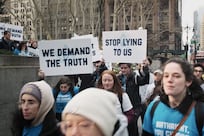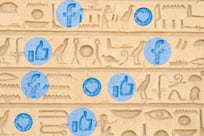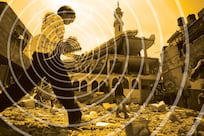At 76, James Rosenquist is one of the last men standing in the pop art movement, which - with everything from Andy Warhol's soup cans to Rosenquist's massive, 1964 anti-war collage F-111 - deployed advertising's imagery and style to depict objects once deemed unworthy of art. Rosenquist is still going strong, with an energy that seems almost boyish. His new memoir, Painting Below Zero: Notes on a Life in Art, revisits eight decades, six of them in New York City.
Unlike Warhol, a compulsive collector who stockpiled an archive of information about himself (including receipts for every penny he spent), Rosenquist had no such repository to tap for an autobiography. His book is a voluble, from-the-hip monologue, dictated into a tape recorder that he entrusted to his co-writer, David Dalton. "David Dalton said: 'You should do a book before you forget,'" Rosenquist said from Aripeka, Florida, north of Tampa, where he makes all of his paintings these days. "So I sat down and I started taping my recollections for hours and hours and hours. David transcribed them, fixed up grammar and added a little bit here and there about names and places that he knew and I didn't, because all I had was my memory. "
Rosenquist was born in 1933 in Grand Forks, North Dakota, where "a dollar was a rare as frog hair" but the sky was vast. He was the only child of parents of Swedish descent who travelled around North Dakota and the neighbouring Minnesota seeking work. "My parents were aviators," said Rosenquist, who was named after an uncle who died in a plane crash in 1931. "The land was flat, so people wanted to go up in the air. If you're standing on the Great Plains, it feels as if you're standing on some kind of a dome. The sky is really the landscape."
Scorned by outsiders as empty and dull, the northern Midwest landscape in Rosenquist's memoir is dreamy and mysteriously quirky, much like his oversized work. "It's all autobiographical, that's all it is," he said, retelling stories from his childhood in a nasal twang that survived decades in Manhattan. "When I was little, I ran into the Minneapolis Art Institute, and I ran home. I said: 'Mama, mama, they have dead bodies in there and they haven't buried them yet.' They just happened to be Egyptian mummies, but I didn't know what an Egyptian was. Then, back in North Dakota, my great-grandfather died in the winter, but it was so frozen that they couldn't bury him. So they stood him up on a porch. My Aunt Dolores and I would walk to school in the morning, and I'd say: 'Bye-bye, grandpa.' I'd see him for a month or so before they put him in the ground."
It's an odd, disturbing image, yet no more bizarre than the 50-foot actresses that Rosenquist painted on Manhattan billboards in the 1950s or the giant automobiles of his paintings. Rosenquist recalls another childhood moment: "During the Second World War, I saw an exhibition in Ohio of three things on the wall - a flower, a little painting and a shrunken head. To me, it was an idea of early collage. The images are expendable, but it leaves you with an idea or a shock. I think that's what collage is."
Rosenquist savours his taste for the incongruous. "That's where the sparks come from," said the man who put an auto grille, a sleeping woman and spaghetti together in I Love You With My Ford (1961). Trained at the Art Students League in New York, Rosenquist also learnt on the job, painting billboards from rickety scaffolding. For a young man with a polished technique, it was easier than farm work. "People say that I used my billboard technique to make art," he writes in the book. "Baloney! I used my art technique to make billboards."
"After that, I brought my billboard techniques to painting because I could paint anything," he said. "If you gave me a sketch, I could paint the damn thing. So what I did was I made my own sketches and I painted the damn thing." He admired the abstract expressionists: "Those artists kept working through the Great Depression, when the future looked almost hopeless. They were artists' artists - Rothko, De Kooning, Barney [Barnett] Newman. I met all those guys. I never met Pollock. I was in a different part of New York when he hit a tree. They were intrepid. They kept painting whether they were making money or not making money - unlike some people who think art is just a business, so they get into it and if they don't become a big art star, they quit."
In Painting Below Zero, Rosenquist notes that Jasper Johns and Robert Rauschenberg, two peers and friends, were not mere "schmearers", implying that his generation had surpassed its elders, who dripped paint notoriously on their canvases. Yet the author disputed the notion that his generation had abandoned abstraction for familiar objects. "It's not abandoning abstract painting," he stressed. "It's trying to be more abstract.
"What do artists try to do? They try to push the boundaries out further and make new inventions in a way that pushes art ahead. "My idea was, after painting huge signs in Times Square, 395 feet wide and seven stories tall, I thought: 'Can I use imagery painted so large that you would have a hard time recognising it, so it would be just colour and form, but in actuality it would be a real image?' "I could try, on a picture plane," he explained, "to place generic images of different sizes, so that the last image would be so big that it would be hard to recognise. It would be like a blanket thrown over your head, but it would still be there. I thought I was pushing art further out, after totally abstract non-objective painting."
That approach was a hard sell in the early 1960s. The memoir is full of the prices that Rosenquist's paintings brought, usually in three figures, although his first museum sale was Nomad (1963), a painting of sculptural shapes and a box of detergent from his migratory childhood that went to the Albright-Knox Museum in Buffalo for all of $4,500 (Dh16,528). Poverty bred collegiality back then, said the painter: "I don't think there was any backbiting. Nobody was selling." Rosenquist recalled celebrating Rauschenberg's sale of a collage for $500. "Artists were championing anybody to sell anything, which means maybe I can sell something eventually. We were all so hungry." Rosenquist remembered his elation on seeing that Johns, awash in cash from a sale, was suddenly driving a white Jaguar.
Sales were few, yet costs were low back then. Rosenquist lived in an apartment for $30 a month, and rented a studio for $40. "What a luxury, I thought, living for nothing in a cosmopolitan city," he said. "I was given a lot of names before pop artist," said the painter whose works are now icons of that era. "I was called a new realist, I as called a Russian realist, I was called a surrealist. My idea was to try to use advertising imagery, which I hated, but to use the technique differently from what it was meant to be. There it was right smack dab in front of you, but it really meant the opposite."
Rosenquist intended the sheer scale of his work to subvert the imagery of advertising. "Whenever I moved into a new place, I'd make a painting that was as big as the height of the ceiling. I'd make the biggest thing I could. No one else was doing anything like that," he recalled. Those huge paintings usually had a political dimension. During the war in Vietnam, Rosenquist placed a smiling child under a hairdryer that resembled a helmet in his painting F-111. "What intrigued me was all these middle-class families prospering from building this death-dealing machine."
For years, he fought ardently for government funding of the arts in the US. He lost ground in that battle but supported politicians who took his side. "Most of them lost," said the painter, with a laugh. He noted that Barack Obama was an exception. Rosenquist's career has soared with the prices of his work. Yet last April, a forest fire that swept through his studio destroyed most of the art that he still owned. Rosenquist, who had already lost most of his pop art contemporaries, faced the loss of his art with the same plain-spoken temperament that turned a lonely boy on the Great Plains into an optimist. He went back to work.
"If you don't keep running," he said, "you get run over."




